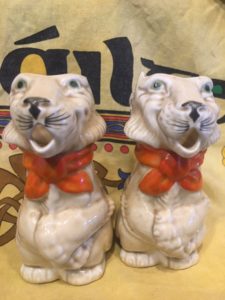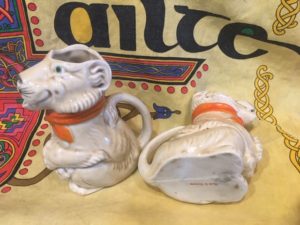 MM grew up with two identical German antique milk pitchers representing twin sentimental looking lions. She got a brilliant idea and plans to give them to her great-great nephews, who are twins, born to her great niece in Pennsylvania.
MM grew up with two identical German antique milk pitchers representing twin sentimental looking lions. She got a brilliant idea and plans to give them to her great-great nephews, who are twins, born to her great niece in Pennsylvania.
The gift isn’t completely ‘accurate.’ The pitchers are identical, a matched pair, and the two babies are fraternal twins. But this gift comes with a legacy. MM’s grandmother had a twin, and as they say, twins run in families. Matched pairs of porcelain pre-WWI pitchers do NOT. Porcelain objects made for children are rare! And according to MM’s story, three generations used these pitchers, soon four.
After the First Great War Germany became a very different place. The last years of the 19th century and the first years of the 20th century were a very happy and prosperous time for the middle and upper stratosphere of society. The Grand Hotels boomed and the favorite pastime at such hotels was spa bathing, and taking the waters. Bands payed, boats sailed on little lakes. The art of the period was equally indulgent, sentimental and nostalgic. Before Germany launched full into the first quarter of the 20th century, they ordered a good dose of sweetness and light. Two stylistic touches to look for in this period are the anthropomorphism, and a devotion to ancient myths.
For MM’s antique pitchers, let us talk about anthropomorphism.
The lions, on their way to Pennsylvania shortly, smile, their paws crossed, and their red neckerchiefs tied in a bow. Their eyes shine blue. Designed for children’s use, their little tails act as a pitcher handle. They definitely appear sweet. The concept of the king of beasts pouring milk from their teeth adds to the lighthearted sentimentality.
Sentimentality became the order of the day in fine art for grownups as well. Old German mythical images featured in the paintings of the period, with beautiful maidens and flower- bedecked, flowing hair. The colors of the day were light and sugary, pinks, blues, and yellows. They also favored historical themes. One of the most typical representations of this era are the German Piano Babies, sometimes full sized infant models in porcelain, dressed in cute skimpy clothing perched on the grand piano in many a upper class parlor. Wine bottle stoppers carved of wood represented trolls and old men, and sometimes fat friars. You get the picture; this was a time of almost cloying sentiment.
The best of this era is fun, like MM’s antique pitchers.
 On the bottom of the pitchers I see ‘made in Germany.’ That tells me they were made after the import-export laws ordered porcelain marked with the country of origin, and before Germany became Two Germanys, East and West.
On the bottom of the pitchers I see ‘made in Germany.’ That tells me they were made after the import-export laws ordered porcelain marked with the country of origin, and before Germany became Two Germanys, East and West.
The import-export laws came into force at the turn of the last century. My dating of the pair is based on that fact, and the sentimental look of these children’s objects.
Another note on the perception of children in Germany of the period:
Children were doted upon, dressed up, and given fine porcelain for their milk in the morning. This dotage applied to the haves not the have-nots, whose children likely started working at age eight.
MM believes her grandmother gifted them to her daughter, MM’s mom, born in 1920. That makes total sense if MM’s grandmother bought them second hand. In other words, if MM’s grandmother was frugal, because antique and fine objects went cheap in 1920 Germany. 1920-23 were Germany’s years of crisis, as the democracy faced turmoil and the economy plummeted. Objects like MM’s pitchers, miraculously intact, might have been purchased for a song from a once-wealthy family at that time. MM writes me that the tradition of these continued in her childhood, where her sister and she had one lion each for their morning cereal. I love that these little beauties have lived to tell this wonderful story and might, if the new twins in Pennsylvania grow up careful, live to tell breakfast stories for a new generation.
The value of MM’s pitchers, if sold at auction, would be $250 at the most, but MM, insure them for $250 for their trip to the twins!